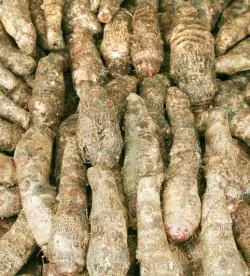We’re occasionally asked about taro and poi – and whether or not they are safe for babies to eat. So we thought we’d make this interesting vegetable the subject of today’s post!
You may not be familiar with taro, which is hugely popular in some parts of the world and virtually unknown in others!
Taro is a root vegetable. It originated in southeast Asia but is now widely available. It is rather strange in appearance – the larger roots can be very fat and either egg-shaped or round. Sometimes, the roots are more oblong in shape. The skin is thick, very rough – and often hairy!
Taro flesh can be white, or slightly grey/purple in colour, with little purple or brown flecks.
Smaller tubers, which come from further along the root, are sometimes known as eddoes.
The benefits
Taro is similar to the potato, but much more nutritious and an excellent source of energy! Taro contains
- potassium
- carbohydrates
- vitamins C and E
- magnesium
- folate
- B vitamins
- protein
Taro is a very gentle food – it is EXTREMELY digestible and hypoallergenic.
Isn’t taro poisonous?
You may have heard that you need to be careful when cooking taro… but may not be sure why.
Taro roots and leaves contain an irritant called calcium oxalate, which can cause an uncomfortable itching in the throat. But thorough cooking breaks down the calcium oxalate, making the taro safe to eat.
You should always wash your hands after preparing raw taro, though – otherwise you risk irritation to your skin or eyes.
Sources:
justhungry.com
vegetables.co.nz
Fermented taro
Fermented taro is known as “poi”. It is particularly important in Hawaii, where it has huge cultural significance. Poi is made by mashing cooked taro with a little water, then setting it aside to ferment, sometimes for several days.
Freshly prepared poi is sweet, but after a few days of fermentation it takes on a “tangy”, sour taste – like yogurt.
During the fermentation process, lactic acid is produced, which digests the starch in the taro. The resulting poi is rich in digestive enzymes and is believed to be an extremely healthy food.
In some parts of the world, babies with an allergy to dairy are given poi as a milk substitute because it is so nutritious.
Cooking taro
Because taro is high in starch, it is better cooked using moist heat (i.e. boiling or steaming) than by baking, which can leave it a little dry.
Smaller roots can be scrubbed, then boiled whole in water and peeled afterwards. You should peel larger roots and cut them into chunks, as you would with potatoes.
And you boil or steam taro chunks as you would potatoes, too, until the chunks are “fork tender”. You can then puree the chunks in a food processor with a little water if you desire.
Although some people make their own poi by allowing the resulting mixture to “sit” in a cool place to ferment, some experts say that it’s safer to ferment taro in a home incubator. For this reason, you may prefer to obtain commercially prepared poi, which – if not available locally – is available online in various forms.
Taro itself takes on the flavour of sauces it is cooked in or added to. This makes it a great thickener for soups or stews for your baby – you can either dice it and cook it along with the other ingredients, or cook it separately, mash it and stir it in afterwards.
Taro is very versatile – so try substituting it in dishes where you would otherwise use white potato.
But please remember – you should always speak to a pediatrician before introducing any new foods to your baby.
External links for more information about poi
Do you have any experience of cooking either taro or poi? Are you a believer in the health giving properties of poi? Then we’d love to hear from you!
Please contact us and share your experiences, ideas and recipes.
Readers’ Comments…
From Michael in Tennessee:
Thank you for the Taro for babies article.
I grow taro in NE Tennessee.
When my granddaughter was tiny she couldn’t tolerate anything except Isomil®, and then she still had terrible colic. I fed her boiled taro root and some of my poi. She loved it, kept it down, and had no negative reaction.

